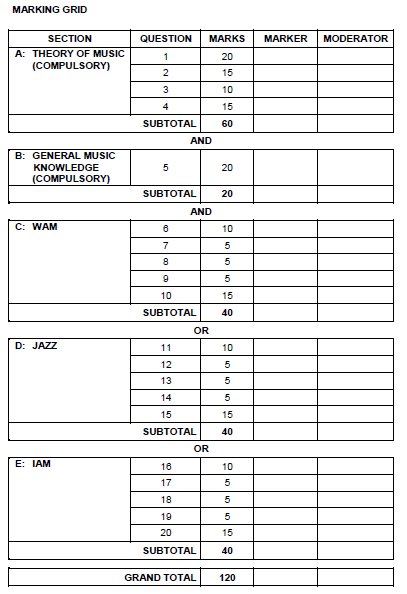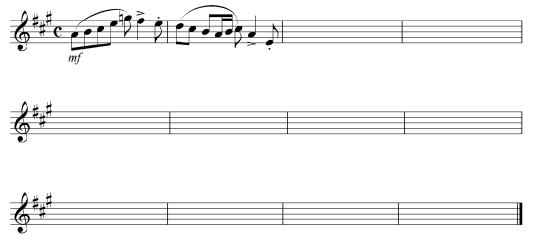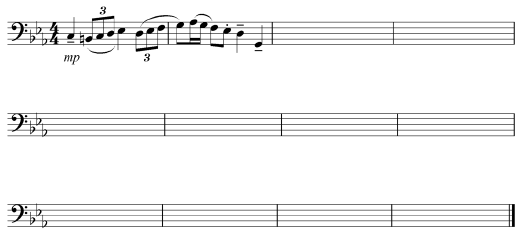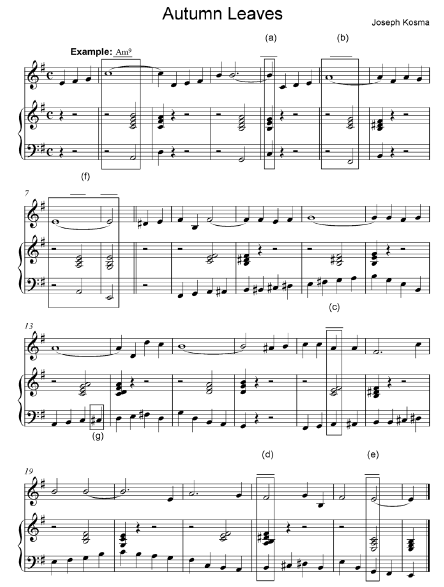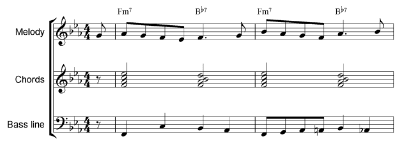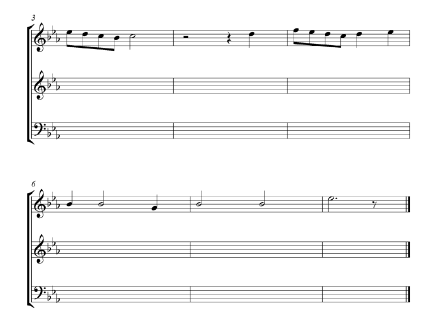MUSIC P1 Past Paper FEBRUARY/MARCH 2016 - GRADE 12 NATIONAL SENIOR CERTIFICATE
Share via Whatsapp Join our WhatsApp Group Join our Telegram GroupMUSIC P1
FEBRUARY/MARCH 2016
MARKS: 120
TIME: 3 hours
INSTRUCTIONS AND INFORMATION
- This question paper consists of FIVE sections, namely SECTIONS A, B, C, D and E.
- SECTIONS A and B are compulsory.
- SECTION C: WESTERN ART MUSIC (WAM), SECTION D: JAZZ and SECTION E: INDIGENOUS AFRICAN MUSIC (IAM) are choice questions. Answer only ONE of these sections (SECTION C or D or E).
- Write all music notation in SECTION A in pencil and all written text in blue or black ink on this question paper.
- Answer SECTION B and SECTION C or D or E in blue or black ink in the ANSWER BOOK provided.
- Number the questions correctly according to the numbering system used in this question paper.
- The last page of this question paper is manuscript paper intended for rough work. Candidates may remove this page.
- Candidates may NOT have access to any musical instrument for the duration of this examination.
- Write neatly and legibly.
SECTION A: THEORY OF MUSIC (COMPULSORY) (90 minutes)
Answer QUESTION 1
AND QUESTION 2.1 OR 2.2
AND QUESTION 3.1 OR 3.2
AND QUESTION 4.1 OR 4.2.
Answer the questions in the spaces provided on this question paper.
QUESTION 1 (25 minutes)
Study the score below and answer the questions that follow.
1.1 Name the key of this extract.
___________________________________________ (1)
1.2 Name the intervals at 1.2.1 and 1.2.2 according to type and distance.
1.2.1 ___________________________________
1.2.2 ___________________________________ (2)
1.3 Name the type of triad at 1.3.1 and 1.3.2, for example minor triad. (Consider only the notes in the block on the score.)
1.3.1 ___________________________________
1.3.2 ___________________________________ (2)
1.4 Circle a chord that forms a dominant seventh chord in root position on this score. (1)
1.5 Transpose bar 3 of the solo part a minor third lower for the E-flat alto saxophone. Add a new key signature. (3)
1.6 Transcribe bar 5 of the piano part (right hand) for viola at the same pitch. Use the correct clef. (3)
1.7 Rewrite bar 1 of the piano part (right hand), but halve the note values. Add a new time signature. (3)
1.8 Complete the following to form a pentatonic scale: (2)
1.9 Write an ascending sequence of the given melodic fragment. (1)
1.10 Compare the music example below with the piano part in bar 5. Which compositional technique is used in the example below?
______________________________________ (1)
1.11 Add a performance indication(s) to the extract below to instruct the performer to play legato.
______________________________________ (1)
[20]
QUESTION 2 (25 minutes)
Answer EITHER QUESTION 2.1 OR QUESTION 2.2.
2.1
Complete the opening motif below to form a twelve-bar melody in ternary form for any single-line melodic instrument of your choice. Name the instrument for which you are writing. Indicate the tempo and add dynamic and articulation marks.
Instrument: ____________________________________
The melody will be marked according to the following criteria:
| DESCRIPTION | MARK ALLOCATION | CANDIDATE'S MARKS |
| Form and cadential points | 3 | |
| Correctness Note stems, beats per bar, accidentals, spacing, layout | 2 | |
| Quality - Quality of melody and suitability for chosen instrument - Appropriate dynamic and articulation indications - Musicality | 10 | |
| TOTAL | 15 |
[15]
OR
2.2
Complete the opening motif below to form a twelve-bar melody in ternary form for any single-line melodic instrument of your choice. Name the instrument for which you are writing. Indicate the tempo and add dynamic and articulation marks.
Instrument: ____________________________________
The melody will be marked according to the following criteria:
| DESCRIPTION | MARK ALLOCATION | CANDIDATE'S MARKS |
| Form and cadential points | 3 | |
| Correctness Note stems, beats per bar, accidentals, spacing, layout | 2 | |
| Quality - Quality of melody and suitability for chosen instrument - Appropriate dynamic and articulation indications - Musicality | 10 | |
| TOTAL | 15 |
QUESTION 3 (10 minutes)
Answer EITHER QUESTION 3.1 OR QUESTION 3.2.
3.1 Study the score below and answer the questions that follow.
3.1.1 This piece modulates in bars 11–133. Name the new key.
__________________________________________ (1)
3.1.2 A second modulation occurs in bars 14–16. How is the new key in these bars related to F major? __________________________________________ (1)
3.1.3
Identify the chords from (a)–(e) and figure them on the score. Use EITHER figuring symbols below the score OR chord symbols above the score. (Note the example in bar 1.) (5)
3.1.4 Name the cadence at (f). _________________________ (1)
3.1.5 Name the type of non-chordal notes at (i) and (ii). (2)
[10]
3.2 Study the score below and answer the questions that follow.
3.2.1 This piece modulates in bars 122–162. Name the new key.___________________________(1)
3.2.2 Identify the chords from (a)–(e) and write chord symbols above the score. (Note the example in bar 1.) (5)
3.2.3 Write the chord progression and the name of the cadence at (f).________________________ (2)
3.2.4 Name the type of non-chordal note at (g).________________ (1)
3.2.5 Name the stylistic feature used in the bass clef from bars 9–24.________________________ (1)
[10]
QUESTION 4 (30 minutes)
Answer EITHER QUESTION 4.1 OR QUESTION 4.2.
4.1
Complete the four-part vocal harmonisation below by adding the alto, tenor and bass parts. Use at least TWO non-chordal notes.
The harmonisation will be marked according to the following criteria:
| DESCRIPTION | MARK ALLOCATION | CANDIDATE'S MARK |
| Chord progression Choice of chords, correct use of cadence | 12 | |
| Correctness Notation, doubling, spacing, voice leading | 12 | |
| Quality Bass line, musicality, non-chordal notes, awareness of style, innovation, creativity | 16 | |
| 40 (÷8x3) | ||
| TOTAL | 15 |
[15]
OR
4.2
Complete the piece below by adding a suitable bass line and harmonic material in the incomplete bars. Continue in the style suggested by the given material in bars 1 and 2 and add the chord symbols above the melodic line.
The harmonisation will be marked according to the following criteria:
| DESCRIPTION | MARK ALLOCATION | CANDIDATE'S MARK |
| Chord progression Choice of chords, correct use of cadence | 12 | |
| Correctness Notation, doubling, spacing, voice leading | 12 | |
| Quality Bass line, musicality, non-chordal notes, awareness of style, innovation, creativity | 16 | |
| 40 (÷8x3) | ||
| TOTAL | 15 |
[15]
TOTAL SECTION A: 60
SECTIONS B, C, D, E: GENERAL MUSIC KNOWLEDGE (90 minutes)
Answer SECTION B
AND SECTION C (Western Art Music)
OR SECTION D (Jazz)
OR SECTION E (Indigenous African Music).
Answer these questions in the ANSWER BOOK provided.
SECTION B: GENERAL (COMPULSORY)
QUESTION 5
5.1
Four options are provided as possible answers to the following questions. Choose the answer and write only the letter (A–D) next to the question number (5.1.1–5.1.10) in the ANSWER BOOK, for example 5.1.11 E.
5.1.1 A chromatic note is ...
- a note that belongs to the key currently in use.
- the technical name for the seventh degree of a scale.
- a note that does not belong to the key currently in use.
- a note that belongs to the diatonic scale.
5.1.2 A capella refers to ...
- a voice accompanied by an organ.
- choral music without instrumental accompaniment.
- accompanied ensemble singing.
- an instrumental ensemble playing in a chapel.
5.1.3 The sound of an aerophone is generated by ...
- a vibrating air column.
- a vibrating string.
- a vibrating vellum.
- the instrument's own material.
5.1.4 Syncopation is ...
- a melody note on the first beat of the bar.
- a rhythmic harmonic device.
- an accented note on a weak beat.
- All the above-mentioned
5.1.5 What is transcription?
- Adding dynamic indications to a score
- Music written in a different clef changing pitch
- Music written at the same pitch for a different instrument
- Transposing the main theme of a composition
5.1.6 A motif is ...
- a short melodic or rhythmic fragment.
- a lyrical vocal passage in music.
- the setting of several notes to one syllable.
- a repeated note with changing harmonies.
5.1.7 To register a new composition you need to ...
- register the work at a collection agency.
- post the work to yourself to establish the date of creation.
- get a commissioner of oaths to certify your work.
- All the above-mentioned
5.1.8 Which ONE of the following is NOT example of music piracy?
- Photocopying of sheet music for a band performance
- Illegal recordings of radio, TV or live concerts
- Selling counterfeit recordings as original recordings
- Transcribing a solo with permission from the performer
5.1.9 Pizzicato is ...
- an instruction to string players to pluck the strings.
- the opposite of arco.
- an Italian music term used in a string quartet.
- All the above-mentioned
5.1.10 The term scherzando means …
- a slow tempo.
- a jest or joke.
- a neutral mood.
- to play staccato. (10 x 1)(10)
5.2 Describe any TWO of the terms below. Write the answers next to your choices (5.2.1–5.2.6) in the ANSWER BOOK.
5.2.1 Rubato
5.2.2 Libretto
5.2.3 Scatting
5.2.4 Substitution chord
5.2.5 Melorhythm
5.2.6 Ukuvamba (2 x 2) (4)
5.3 An independent composer has certain rights with regard to his/her compositions. State SIX of these rights. (6)
TOTAL SECTION B: 20
Answer SECTION C (WAM)
OR SECTION D (JAZZ)
OR SECTION E (IAM).
SECTION C: WESTERN ART MUSIC (WAM)
QUESTION 6
6.1
Complete the table below representing the schematic layout of the three movements from Beethoven's Symphony No. 6 in F Op. 68 by writing down the missing words.
Write only the answer next to the question number (6.1.1–6.1.6) in the ANSWER BOOK, for example 6.1.7 Cadenza.
| MOVEMENTS | TITLE | FORM | TEMPO INDICATION |
| First movement | Awakening of cheerful feelings upon arrival in the country | 6.1.1 | 6.1.2 |
| Fourth movement | 6.1.3 | Free form | 6.1.4 |
| Fifth movement | 6.1.5 | 6.1.6 | Allegretto |
(6)
6.2
Name the woodwind instrument that Beethoven added in the fourth movement of his Symphony No. 6. (1)
6.3
Beethoven's Symphony No. 6 has five movements. When listening to the work, it may sound as if there are only three movements. Briefly state the reason for this. (1)
6.4
Study the themes below from Symphony No. 6 and identify the movement in which each appears. (2)
[10]
QUESTION 7
7.1 In which prescribed work does the following theme appear? (1)
7.2 What is the form structure of this work? (1)
7.3 Explain what inspired the composer to write this work. (3)
[5]
QUESTION 8
Write a paragraph in which you explain the differences AND similarities between an overture and a concert overture. [5]
QUESTION 9
Write a paragraph on the role which the Mannheim School played in the development of the symphony orchestra. [5]
QUESTION 10
'Mozart's opera The Magic Flute can be regarded as both comic and serious.'
Write an essay in which you discuss the statement above by referring to Mozart's use of characters, voice types and elements of music in the following TWO arias:
- Der Vogelfänger bin ich ja (Yes, I am the birdcatcher)
- Die Hölle Rache kocht in meinem Herzen (The wrath of hell boils in my heart)
THREE marks will be awarded for the logical presentation of facts and the structure of your essay.
[15]
TOTAL SECTION C: 40
OR
SECTION D: JAZZ
QUESTION 11
11.1
Choose an instrument from COLUMN B that matches any FOUR artists in COLUMN A. Write only the letter of your choice (A–F) next to the question number (11.1.1–11.1.5) in the ANSWER BOOK, for example 11.1.6 G.
| COLUMN A | COLUMN B |
| 11.1.1 Todd Matshikiza 11.1.2 Elias Lerole 11.1.3 Winston Ngozi 11.1.4 Philip Tabane 11.1.5 David Masondo | A piano B saxophone C guitar D voice E pennywhistle F drum kit |
(4 x 1) (4)
11.2
Name the leader of TWO of the South African jazz bands or groups below. Write the answers next to your choices (11.2.1–11.2.3) in the ANSWER BOOK.
11.2.1 The Blue Notes
11.2.2 Manhattan Brothers
11.2.3 Sakhile (2)
11.3 Give FOUR reasons why the pennywhistle was a popular instrument in the 1930s. (4)
[10]
QUESTION 12
Write a paragraph on Cape jazz by referring to the following features:
- Melody (2)
- Rhythm (1)
- Instrumentation (2) [5]
QUESTION 13
Write a paragraph on the style of music that ONE of the following bands represents. Name the style in your answer and elaborate on the music features of this style.
- Makgonatsohle Band
- Soul Brothers
- The Cool Crooners [5]
QUESTION 14
Marabi developed in the townships around the major South African cities during the 1920s and 1930s. Write notes on the social and musical origins of this style. [5]
QUESTION 15
Choose ONE of the following artists/groups:
- Zim Nqawana
- Sakhile
- Spirits Rejoice
Write an essay outlining the history of the artist/group as well as the music style characteristics of your chosen artist/group. Name at least TWO hits/albums.
THREE marks will be awarded for the logical presentation of facts and the structure of your essay.
[15]
TOTAL SECTION D: 40
OR
SECTION E: INDIGENOUS AFRICAN MUSIC (IAM)
QUESTION 16
16.1 Choose the cultural groups from COLUMN B that match any FOUR dances in COLUMN A. Write only the letter of your choice (A–I) next to the question number (16.1.1–16.1.9) in the ANSWER BOOK, for example 16.1.10 J.
| COLUMN A | COLUMN B |
| 16.1.1 Domba 16.1.2 Xincayincayi 16.1.3 Umtyityimbo 16.1.4 Mokorotlo 16.1.5 Sekgapa 16.1.6 Borankana 16.1.7 Itshikiza 16.1.8 Umtsimba 16.1.9 Inkwahla | A baPedi B amaSwati C amaZulu D amaXhonga E amaXhosa F amaNdebele G baTswana H baSotho I vhaVenda |
(4 x 1) (4)
16.2 State TWO functions of crepitation during a music performance. (2)
16.3 State FOUR ways in which musical development of children occurs within traditional South African societies. (4)
[10]
QUESTION 17
Write a paragraph on the style of music that ONE of the following bands represents. Name the style in your answer and elaborate on the music features of this style.
- Makgonatsohle Band
- Soul Brothers
- The Cool Crooners [5]
QUESTION 18
Write a paragraph in which you briefly describe maskandi. Refer to the guitar-playing technique, tuning and music features. [5]
QUESTION 19
19.1 Briefly describe malombo. (4)
19.2 Name ONE representative malombo artist/band. (1)
[5]
QUESTION 20
'Indigenous African music is a cultural expression of the ubuntu spirit.'
Write an essay in which you discuss the statement above. Give examples of how ubuntu is portrayed in music and dance.
THREE marks will be awarded for the logical presentation of facts and the structure of your essay.
[15]
TOTAL SECTION E: 40
GRAND TOTAL: 120
